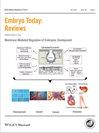Sara Ornaghi, Martin Mueller, Eytan R. Barnea, Michael J. Paidas
下载PDF
{"title":"妊娠期血栓形成:对母亲和胎儿的风险、预防和治疗——利用组学技术、生物标志物和体外或体内模型的力量促进血栓形成的治疗","authors":"Sara Ornaghi, Martin Mueller, Eytan R. Barnea, Michael J. Paidas","doi":"10.1002/bdrc.21103","DOIUrl":null,"url":null,"abstract":"<p>Maternal thromboembolism and a spectrum of placenta-mediated complications including the pre-eclampsia syndromes, fetal growth restriction, fetal loss, and abruption manifest a shared etiopathogenesis and predisposing risk factors. Furthermore, these maternal and fetal complications are often linked to subsequent maternal health consequences that comprise the metabolic syndrome, namely, thromboembolism, chronic hypertension, and type II diabetes. Traditionally, several lines of evidence have linked vasoconstriction, excessive thrombosis and inflammation, and impaired trophoblast invasion at the uteroplacental interface as hallmark features of the placental complications. “Omic” technologies and biomarker development have been largely based upon advances in vascular biology, improved understanding of the molecular basis and biochemical pathways responsible for the clinically relevant diseases, and increasingly robust large cohort and/or registry based studies. Advances in understanding of innate and adaptive immunity appear to play an important role in several pregnancy complications. Strategies aimed at improving prediction of these pregnancy complications are often incorporating hemodynamic blood flow data using non-invasive imaging technologies of the utero-placental and maternal circulations early in pregnancy. Some evidence suggests that a multiple marker approach will yield the best performing prediction tools, which may then in turn offer the possibility of early intervention to prevent or ameliorate these pregnancy complications. Prediction of maternal cardiovascular and non-cardiovascular consequences following pregnancy represents an important area of future research, which may have significant public health consequences not only for cardiovascular disease, but also for a variety of other disorders, such as autoimmune and neurodegenerative diseases. Birth Defects Research (Part C) 105:209–225, 2015. © 2015 Wiley Periodicals, Inc.</p>","PeriodicalId":55352,"journal":{"name":"Birth Defects Research Part C-Embryo Today-Reviews","volume":"105 3","pages":"209-225"},"PeriodicalIF":0.0000,"publicationDate":"2015-09-25","publicationTypes":"Journal Article","fieldsOfStudy":null,"isOpenAccess":false,"openAccessPdf":"https://sci-hub-pdf.com/10.1002/bdrc.21103","citationCount":"5","resultStr":"{\"title\":\"Thrombosis during pregnancy: Risks, prevention, and treatment for mother and fetus—harvesting the power of omic technology, biomarkers and in vitro or in vivo models to facilitate the treatment of thrombosis\",\"authors\":\"Sara Ornaghi, Martin Mueller, Eytan R. Barnea, Michael J. Paidas\",\"doi\":\"10.1002/bdrc.21103\",\"DOIUrl\":null,\"url\":null,\"abstract\":\"<p>Maternal thromboembolism and a spectrum of placenta-mediated complications including the pre-eclampsia syndromes, fetal growth restriction, fetal loss, and abruption manifest a shared etiopathogenesis and predisposing risk factors. Furthermore, these maternal and fetal complications are often linked to subsequent maternal health consequences that comprise the metabolic syndrome, namely, thromboembolism, chronic hypertension, and type II diabetes. Traditionally, several lines of evidence have linked vasoconstriction, excessive thrombosis and inflammation, and impaired trophoblast invasion at the uteroplacental interface as hallmark features of the placental complications. “Omic” technologies and biomarker development have been largely based upon advances in vascular biology, improved understanding of the molecular basis and biochemical pathways responsible for the clinically relevant diseases, and increasingly robust large cohort and/or registry based studies. Advances in understanding of innate and adaptive immunity appear to play an important role in several pregnancy complications. Strategies aimed at improving prediction of these pregnancy complications are often incorporating hemodynamic blood flow data using non-invasive imaging technologies of the utero-placental and maternal circulations early in pregnancy. Some evidence suggests that a multiple marker approach will yield the best performing prediction tools, which may then in turn offer the possibility of early intervention to prevent or ameliorate these pregnancy complications. Prediction of maternal cardiovascular and non-cardiovascular consequences following pregnancy represents an important area of future research, which may have significant public health consequences not only for cardiovascular disease, but also for a variety of other disorders, such as autoimmune and neurodegenerative diseases. Birth Defects Research (Part C) 105:209–225, 2015. © 2015 Wiley Periodicals, Inc.</p>\",\"PeriodicalId\":55352,\"journal\":{\"name\":\"Birth Defects Research Part C-Embryo Today-Reviews\",\"volume\":\"105 3\",\"pages\":\"209-225\"},\"PeriodicalIF\":0.0000,\"publicationDate\":\"2015-09-25\",\"publicationTypes\":\"Journal Article\",\"fieldsOfStudy\":null,\"isOpenAccess\":false,\"openAccessPdf\":\"https://sci-hub-pdf.com/10.1002/bdrc.21103\",\"citationCount\":\"5\",\"resultStr\":null,\"platform\":\"Semanticscholar\",\"paperid\":null,\"PeriodicalName\":\"Birth Defects Research Part C-Embryo Today-Reviews\",\"FirstCategoryId\":\"1085\",\"ListUrlMain\":\"https://onlinelibrary.wiley.com/doi/10.1002/bdrc.21103\",\"RegionNum\":0,\"RegionCategory\":null,\"ArticlePicture\":[],\"TitleCN\":null,\"AbstractTextCN\":null,\"PMCID\":null,\"EPubDate\":\"\",\"PubModel\":\"\",\"JCR\":\"Q\",\"JCRName\":\"Medicine\",\"Score\":null,\"Total\":0}","platform":"Semanticscholar","paperid":null,"PeriodicalName":"Birth Defects Research Part C-Embryo Today-Reviews","FirstCategoryId":"1085","ListUrlMain":"https://onlinelibrary.wiley.com/doi/10.1002/bdrc.21103","RegionNum":0,"RegionCategory":null,"ArticlePicture":[],"TitleCN":null,"AbstractTextCN":null,"PMCID":null,"EPubDate":"","PubModel":"","JCR":"Q","JCRName":"Medicine","Score":null,"Total":0}
引用次数: 5
引用
批量引用

 求助内容:
求助内容: 应助结果提醒方式:
应助结果提醒方式:


